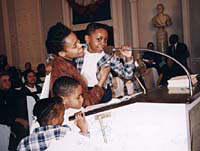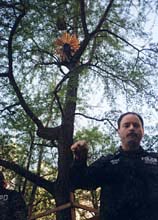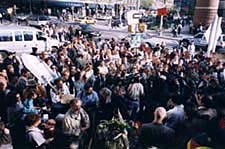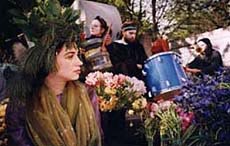
 | |
Freeing the Land One of the most successful grassroots political campaigns to be seen in New York City in recent memory was the spring 1999 campaign to prevent the auctioning off of 119 community gardens. This campaign, an effort which at its roots is a struggle for community control against entrenched political and economic power, brought together a tremendous diversity of people from all over the city with the common goal of protecting precious green space from the hands of greedy real-estate developers; developers whose claims that this destruction was necessary for the construction of affordable housing was, from the outset, a complete fabrication.
The first of these auctionstook place in March of 1998. Three gardens in Manhattan's Lower East Side- Umbrella, Holy Mary Mother of God, and the Seventh Street Garden- were scheduled to be sold. As their second direct action, a number of activists got inside and were able to disrupt the procedures by making false bids on gardens, infuriating the Mayor but drawing city-wide press attention to the community gardens issue. All in all it was a success. While the gardens weren't saved, the issue was now squarely in the public eye. The next move was the Mayor's, and it was one with far reaching implications for the fate of gardens. Green Thumb, the city agency which had overseen the development and running of the community gardnes, was brought under the jurisdiction of the agency of Housing Preservation and Development, the city agency whose primary function is to sell land to developers. This did not bode well for the future of community gardens, and the statements coming out of the Mayor's office made it pretty clear that Rudy's vision for New York wasn't a particularly green one. This transfer is what really mobilized the core of garden activists. There was no question what was coming down the pike. July 20th was the next scheduled auction, and the city planned to sell to speculative real-estate developers 4 community gardens, 2 community centers- one of them the cherished Charas El Bohio Community Center on E. 9th Street- and 19 lots where low income housing could be built. This time the activists had a particularly ingeneous scheme to thwart the Mayor's plans. Calling themselves "Jiminy Cricket" they released ten thousand crickets into the auction hall, delayed the proceedings for hours, and got major coverage on every TV news program and in all thenewspapers. Again, the gardens couldn't be saved, but by now the city, including the city council, had woken up to the issue. Giuliani, it was rumored at the time, was furious, and he would attempt to exact his revenge in the near future. The next big move of the Mayor's wasn't to take place until January, a lull which gave garden activists more time to network and organize a wider resistance to the sell-offs. They faxed, wrote letters, met with council members--did everything possible to stem the tide of privatization. In the meantime the Mayor saw fit to destroy the Children's Garden of Love in November without any advanced warning, as the children watched from their classrooms across the street. The stakes were being raised, the city's tactics becoming more severe. In December of 1998 word was leaked to garden activists that an auction was scheduled for May in which 119 community gardens would be sold off, about 15% of the city's Green Thumb gardens. At first the Mayor's office denied it, but by January they had offically announced the auction, and furthermore they confirmed that this time there would be no restricions placed on the use of the transferred lots. Even the pretext of affordable housing was abaondoned in this latest land grab. Garden activists around the city began to organize. The Garden Coalition mailed all gardens a notice about the auction and when the DCAS (Public Comment) hearing was to be held. The DCAS hearings were strictly a formality to be gone through before green-lighting the sale, and none of the activists thought otherwise, but it gave gardens a way to mobilize their supporters. The press by now had latched onto the story, and not in a way favorable to the mayor. Public hearings were scheduled for January13, 27, and Feb. 10, 24. In one, a
group of second
graders shared their ideas about
In the middle of March, the GreenThumb program had its annual conference called "Grow Together." Activists were there with outreach materials printed in bright colors. These flyers can still be found on garden gates throughout the city, since lots of them were laminated. The pressure was beginning to be felt by the city council and the state legislature, resulting in the introduction, in March, of State and City legislation to save the gardens; legislation which, predictably, stalled in the halls of power and never saw the light of day. By April things had reached a fever pitch. On the weekend of the 10th-11th there were large rallies and demonstrations in Brooklyn and in the East Villiage of Manhattan. In Brooklyn on the 10th, the Brooklyn Alliance of Neighborhood Gardens (BANG), organized a large rally, called "Standing Our Ground" sponsored by the Garden Coalition, the NYC Environmental Justice Alliance, and the NYC chapter of the Sierra Club. Although quite mainstream, one table was manned (and I use the term loosely) by a number of LESC activists promoting the Earth-Shaking Protest and Civil Disobedience to be held May 5, one week before the scheduled auction. The rally included a performance by folk legend Peete Seeger. The next day Reclaim the Streets NYC threw an illegal street
party/demonstration on Avenue A which lasted for close to 3 hours. It was festival of resistance which included garden boxes and
tripods as barricades, a marching band, fire breathing and pirate radio
transmitted dance music. Five arrests were made and more exposure
for the gardens issue was gained, as well as excitement for the upcoming May 5th
action, which was eventually endorsed by around 3 dozen groups.
In the meantime there were court cases pending and offers being made by the Trust for Public Land to purchase the gardens. The city rejected the Trust's $2 million offer to take the majority of the gardens off the block for the ostensible reason that they might be able to squeeze another million out of the property (this at a time when the city was seeing the greatest tax surplus in its history up to that point). The plans for the protest were growing. On Arbor Day (May 1st) garden activist Matt Power,
dressed in his by now familiar Sunflower headdress, climbed a tree
On May 3rd a class action suit was filed by the Green Guerillas and several city lawmakers to block the sale. Bette Midler had by now gotten involved with the New York Restoration Project. They were meeting with the Mayor's office to try and buy the gardens not covered by the concurrent two million dollar offer of the Trust for Public Land. The city still wasn't buying. The protesters weren't about to slow down either, though. On May 5th, at a pre-auction meeting for prospective buyers at the Borough of
Manhattan Community Garden, hundreds of gardeners and
supporters from all over New York City rallied to save the gardens. The sun shone bright. Thousands of
So the gardens were saved, for the meantime. The Mayor discovered that even
his arrogance was not enough to thwart the concerted, dedicated efforts of
We must remember that a threat to one garden is a threat to all gardens, and
a threat to gardens is a threat to communities and to the Earth itself. We must
continue to fight to preserve these urban oases with all the determination and
creativity we can bring to bear. |
 While the fight to save community gardens was perhaps most visible during the
9 months preceding the May 1999 auction, the struggle to protect these spaces
dates back to the mid-80's, when the city first began to bulldoze. During this
period the New York City Coalition for the Preservation of the Gardens (commonly
referred to as the Gardens Coalition) was formed. This group was responsible for
the first networking efforts to unify the 900 or so gardens scattered throughout
the city, and laid much of the groundwork which would later be necessary to
prevent the large scale sell-offs attempted by the Giuliani administration
through the auction process. Of course, the decision to use the auction process
was itself just one more step in an escalating trend of privatization city-wide.
The Mayor had been bulldozing gardens with increasing frequency since 1995, as
real-estate values had increased (due, in no small part, to the existence of
community gardens) and developers sought some payback for their generous campaign
contributions. This ongoing and escalating war on public space, specifically in
the form of gardens, was best typified by developer Donald Cappocia's
While the fight to save community gardens was perhaps most visible during the
9 months preceding the May 1999 auction, the struggle to protect these spaces
dates back to the mid-80's, when the city first began to bulldoze. During this
period the New York City Coalition for the Preservation of the Gardens (commonly
referred to as the Gardens Coalition) was formed. This group was responsible for
the first networking efforts to unify the 900 or so gardens scattered throughout
the city, and laid much of the groundwork which would later be necessary to
prevent the large scale sell-offs attempted by the Giuliani administration
through the auction process. Of course, the decision to use the auction process
was itself just one more step in an escalating trend of privatization city-wide.
The Mayor had been bulldozing gardens with increasing frequency since 1995, as
real-estate values had increased (due, in no small part, to the existence of
community gardens) and developers sought some payback for their generous campaign
contributions. This ongoing and escalating war on public space, specifically in
the form of gardens, was best typified by developer Donald Cappocia's the gardens. In another, on February 24th,
the gardens. In another, on February 24th, Meanwhile, in late January/early February garden activists from the Lower East
Side Collective mailed outreach packets to all gardens threatened by auction and
to key activists city-wide. 20 neighborhoods were identified where the bulk of
the threatened gardens were located, then a 125 word flyer was designed for
handing out to people, on the back listing the threatened gardens in that area
and contact info for local government representatives. These hand-outs were in
English and Spanish. They also designed two English and 2 Spanish flyers for
posting around the city.
Meanwhile, in late January/early February garden activists from the Lower East
Side Collective mailed outreach packets to all gardens threatened by auction and
to key activists city-wide. 20 neighborhoods were identified where the bulk of
the threatened gardens were located, then a 125 word flyer was designed for
handing out to people, on the back listing the threatened gardens in that area
and contact info for local government representatives. These hand-outs were in
English and Spanish. They also designed two English and 2 Spanish flyers for
posting around the city.
 in City Hall Park and demanded to speak with the Mayor about the
auction. He was joined by about 30 or so of his cohorts, who serenaded him
with inspirational songs from underneath the tree as he negotiated with the
police He was eventually convinced to come down, but not before the had an
opportunity to come and watch the spectacle and he had an opportunity to ,
in City Hall Park and demanded to speak with the Mayor about the
auction. He was joined by about 30 or so of his cohorts, who serenaded him
with inspirational songs from underneath the tree as he negotiated with the
police He was eventually convinced to come down, but not before the had an
opportunity to come and watch the spectacle and he had an opportunity to , Irises were distributed by protesters, the Great Small Works Orchestra played
swing music for all to hear, puppets and costumed activists roamed the staid and stultifying auction grounds. Activists
simultaneously
Irises were distributed by protesters, the Great Small Works Orchestra played
swing music for all to hear, puppets and costumed activists roamed the staid and stultifying auction grounds. Activists
simultaneously  gardeners and activists who were determined to protect these isolated oases of
green. The fight is by no means over. 115 gardens were saved. There are
approximately 640 remaining which could still be sold, and while it is unlikely
that the mayor will be so pigheaded as to try a massive one-time sell-off again,
he will continue to sell off gardens, in all likelihood returning to the
time-proven method of getting rid of them in twos and threes. In fact, the Peach
Tree Garden in the Lower East Side is currently scheduled for auction in summer,
2000. Many gardens are being forced through the condominium pipeline, which does
not involve public auction. Instead, developers are chosen in secret (usually by
HPD), and the City Council passes a waiver to sell the land without any hearings,
and the federal government usually throws in subsidies designed to bring the
middle class back into blighted inner-city neighborhoods. This struggle is not
over.
gardeners and activists who were determined to protect these isolated oases of
green. The fight is by no means over. 115 gardens were saved. There are
approximately 640 remaining which could still be sold, and while it is unlikely
that the mayor will be so pigheaded as to try a massive one-time sell-off again,
he will continue to sell off gardens, in all likelihood returning to the
time-proven method of getting rid of them in twos and threes. In fact, the Peach
Tree Garden in the Lower East Side is currently scheduled for auction in summer,
2000. Many gardens are being forced through the condominium pipeline, which does
not involve public auction. Instead, developers are chosen in secret (usually by
HPD), and the City Council passes a waiver to sell the land without any hearings,
and the federal government usually throws in subsidies designed to bring the
middle class back into blighted inner-city neighborhoods. This struggle is not
over.